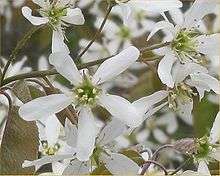Amelanchier canadensis
Amelanchier canadensis (bilberry,[2] Canadian serviceberry, chuckle-berry, currant-tree,[3] juneberry, shad-blow serviceberry, shad-blow, shadbush, shadbush serviceberry, sugarplum, thicket serviceberry) is a species of Amelanchier native to eastern North America in Canada from Newfoundland west to southern Ontario, and in the United States from Maine south to Alabama. It is largely restricted to wet sites, particularly on the Atlantic coastal plain, growing at altitudes from sea level up to 200 m.[4][5][6]
| Amelanchier canadensis | |
|---|---|
 | |
 | |
| Scientific classification | |
| Kingdom: | Plantae |
| Clade: | Tracheophytes |
| Clade: | Angiosperms |
| Clade: | Eudicots |
| Clade: | Rosids |
| Order: | Rosales |
| Family: | Rosaceae |
| Genus: | Amelanchier |
| Species: | A. canadensis |
| Binomial name | |
| Amelanchier canadensis | |
| Synonyms | |
Growth
It is a deciduous shrub or small tree growing to 0.5–8 m tall with one to many stems and a narrow, fastigiate crown. The leaves are alternate, simple, ovate to ovate-oblong, 1–5.5 cm long and 1.8–2.8 cm broad with a rounded to sub-acute apex; they are downy below, and have a serrated margin and an 8–15 mm petiole. The flowers are produced in early spring in loose racemes 4–6 cm long at the ends of the branches; each raceme has four to ten flowers. The flower has five white petals 7.6–11 mm long and 2–4 mm broad, and 20 stamens. The fruit is a pome, 7–10 mm diameter, dark purple when ripe; it is edible and sweet. Fruits become ripe in June and July[5][6] in its native range.
Uses
It is used as a medicinal plant,[7] food, and ornamental plant.[8] It is sometimes made into bonsai.
References
- Botanic Gardens Conservation International (BGCI). & IUCN SSC Global Tree Specialist Group. (2018). "Amelanchier canadensis". The IUCN Red List of Threatened Species. IUCN. 208. e.T135957978A135957980. doi:10.2305/IUCN.UK.2018-2.RLTS.T135957978A135957980.en.
- Canadian Wildlife Federation: Serviceberries
- Amelanchier spp. Family: Rosaceae Serviceberry Center for Wood Anatomy Research, USDA Forest Service
- "Amelanchier canadensis". Germplasm Resources Information Network (GRIN). Agricultural Research Service (ARS), United States Department of Agriculture (USDA). Retrieved 29 December 2017.
- University of Maine: Amelanchier canadensis var. canadensis
- University of Maine: Amelanchier canadensis var. obovalis
- Plants For A Future: Amelanchier canadensis
- Bailey, L. H. (2005). Manual of Gardening. (Second Edition) Project Gutenberg Literary Archive Foundation.
External links
![]()
| Wikiversity has bloom time data for Amelanchier canadensis on the Bloom Clock |
